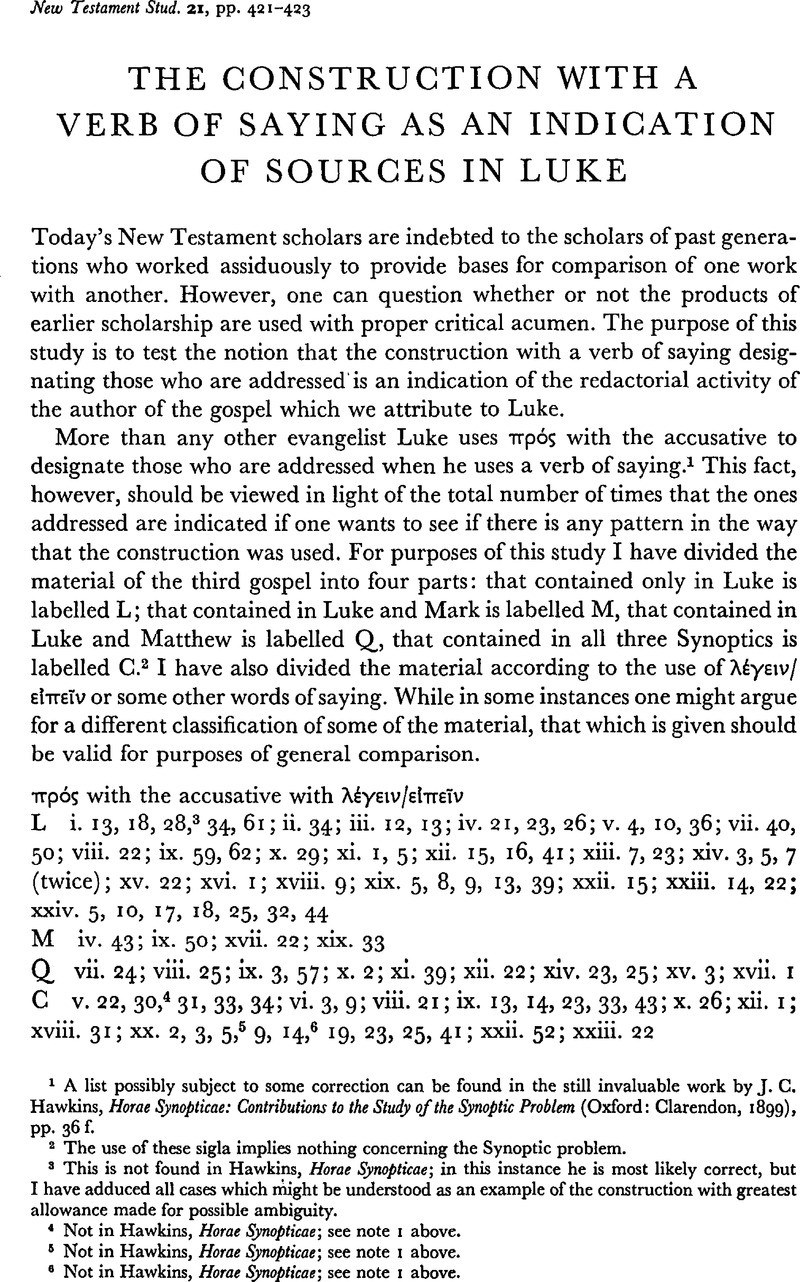No CrossRef data available.
Article contents
The Construction with a Verb of Saying as an Indication of Source in Luke
Published online by Cambridge University Press: 05 February 2009
Abstract

- Type
- Short Studies
- Information
- Copyright
- Copyright © Cambridge University Press 1975
References
page 421 note 1 A list possibly subject to some correction can be found in the still invaluable work by Hawkins, J. C., Horae Synopticae: Contributions to the Study of the Synoptic Problem (Oxford: Clarendon, 1899), PP. 36 f.Google Scholar
page 421 note 2 The use of these sigla implies nothing concerning the Synoptic problem.
page 421 note 3 This is not found in Hawkins, Horae Synopticae; in this instance he is most likely correct, but I have adduced all cases which might be understood as an example of the construction with greatest allowance made for possible ambiguity.
page 421 note 4 Not in Hawkins, Horae Synopticae; see note 1 above.
page 421 note 5 Not in Hawkins, Horae Synopticae; see note 1 above.
page 421 note 6 Not in Hawkins, Horae Synopticae; see note 1 above.
page 423 note 1 This militates against some of the reasoning of Schürmann, H., Der Paschamahlbericht Lk 22, (7–14) 15–18 (Münster Westf.: Aschendorff, 1953), Jesu Abschiedsrede Lk 22, 21–38 (Münster Westf.: Aschendorff, 1957); Der Einsetzungsbericht Lk 22, 19–20 (Münster Westf.: Aschendorff, 1955);Google ScholarRehkopf, F., Die lukanische Sonderquelle: Ihr Umfang und Sprachgebrauch (Tübingen: Mohr, 1959);Google ScholarTaylor, V., The Passion Narrative: A Critical and Historical Investigation (Cambridge University Press, 1972).Google Scholar
page 423 note 2 Thus without foundation is the following statement of Taylor, Passion Narrative 25: ‘More striking is the record of εἰπεν c. dat. (Acts (7), Luke (82) including 65 in L and 15 in Markan sections with 2 added). Apparently Luke found this construction in his sources, his normal usage being εἰπεν πρς.’ πρς with the accusative with λ⋯γειν/εἰπεῖν is found thirty-four times in Acts: i. 7; ii. 12, 28, 37; iii. 25; iv. 8, 16, 19, 23; v. 35; vii. 3; viii. 20, 26; ix. 10, 15; xii. 8; xiii. 15 (twice – lacking in Hawkins, Horae Synopticae); xv. 7, 36; xviii. 6, 14; xxi. 37; xxii. 8, 10, 21, 25; xxiii. 3; xxv. 22; xxvi. 28, 31; xxviii. 17, 21. The simple dative with λ⋯γειν/εἰπεῑν is found thirty-two times: ii. 34; iv. 32; v. 8, 35; vii. 33, 37, 46; viii. 29, 34; ix. 4, 34; x. 3, 4, 19; xi. 12; xvi. 18, 20; xviii. 9; xix. 15; xx. 18; xxi. 4, 23, 27; xxii. 7, 10, 27 (twice); xxiii. 1, 14; xxv. g; xxvii. 10, 31. Expressed percentually πρ⋯ς with the accusative is used 51.5% of the time and the simple dative 48.4% of the time with λ⋯γειν/εἰπεἰν in Acts. Overall in Luke the former construction is found 34.9% of the times and the latter 64.2% of the times.




